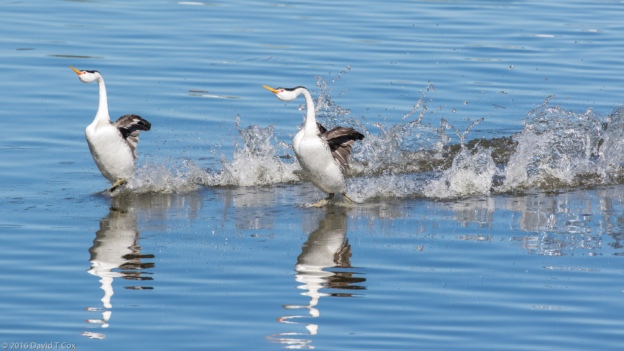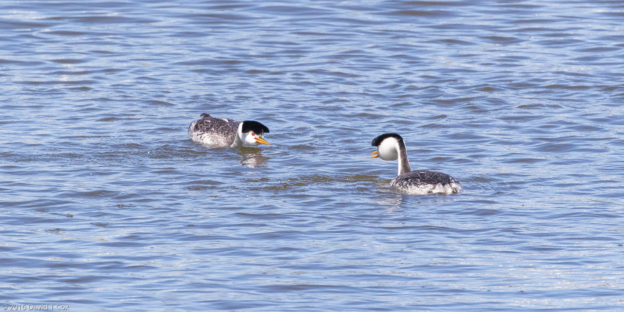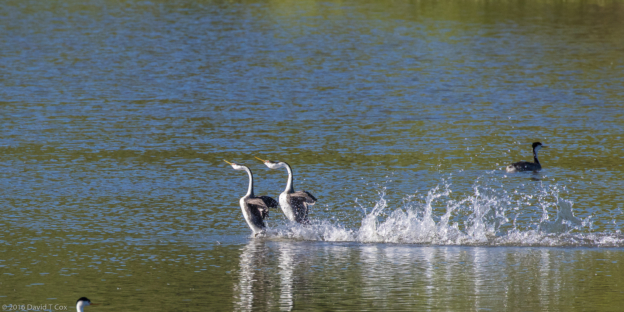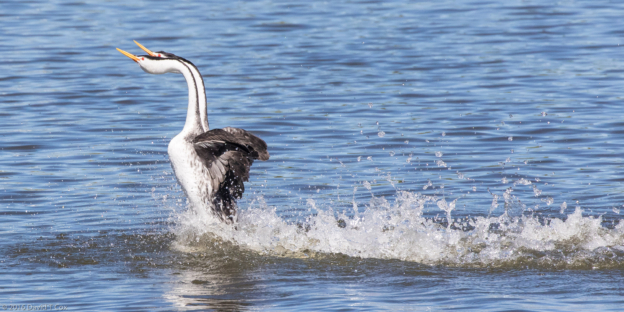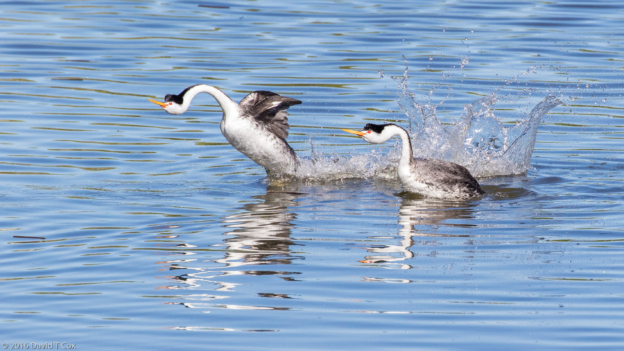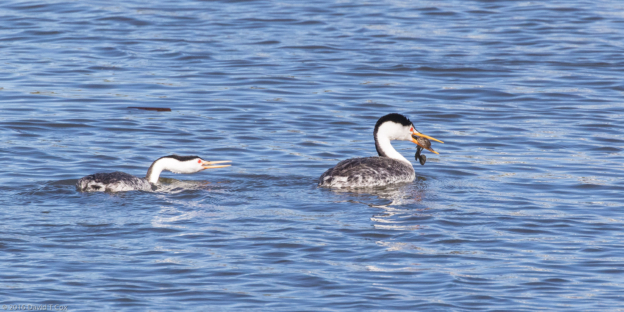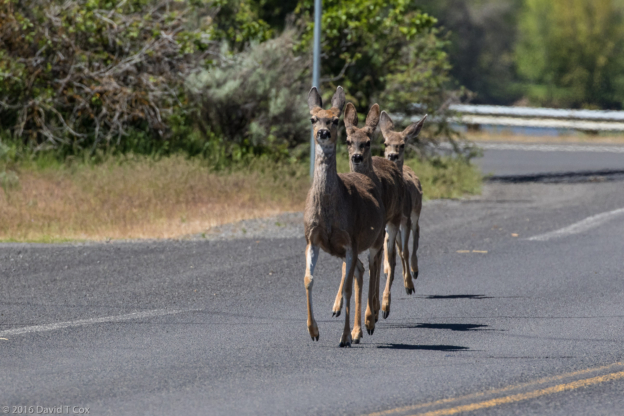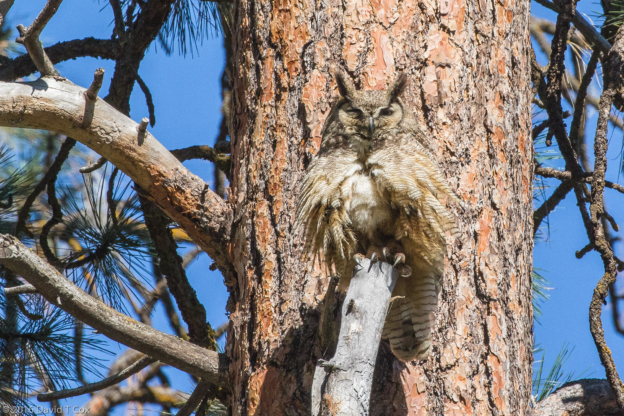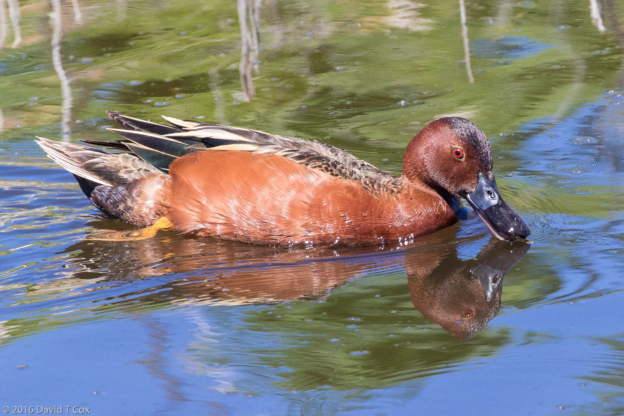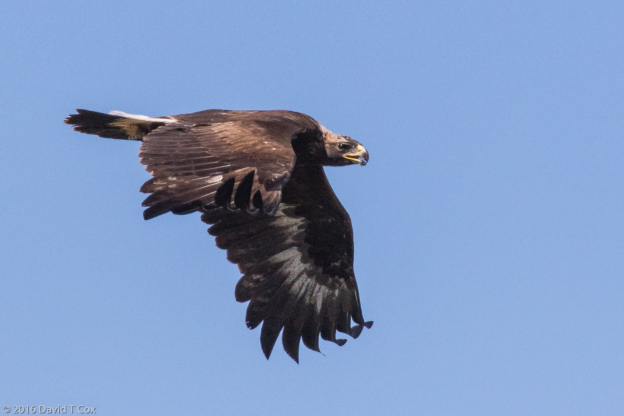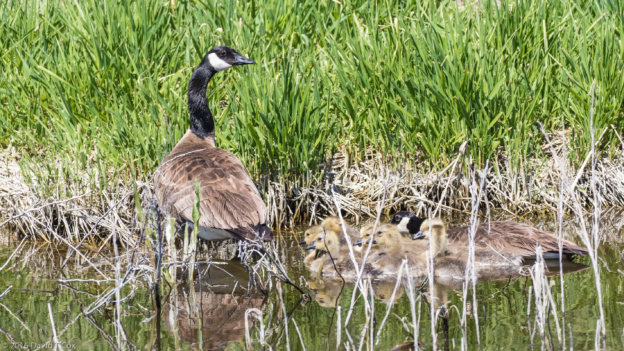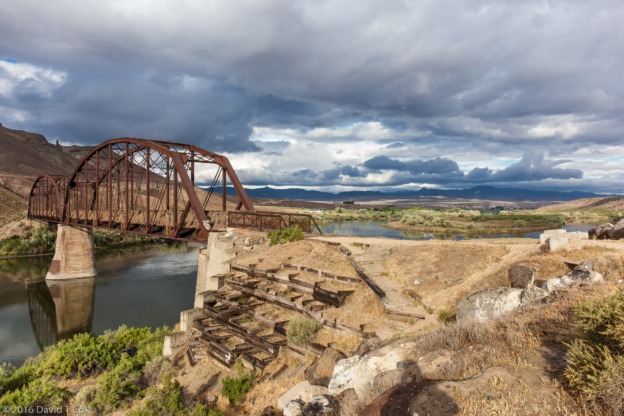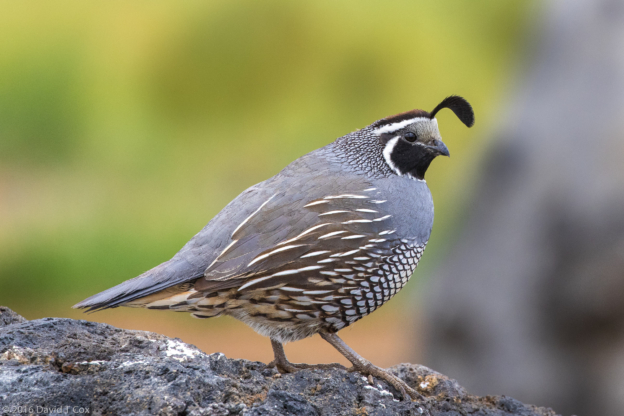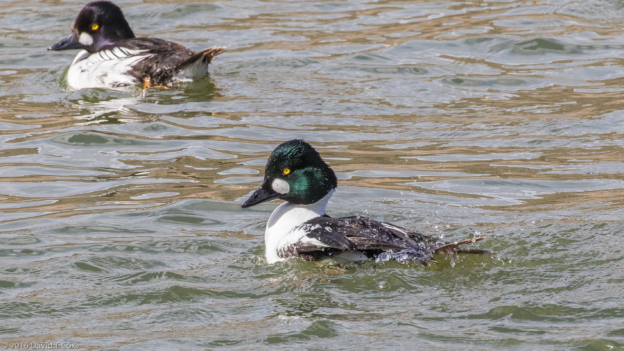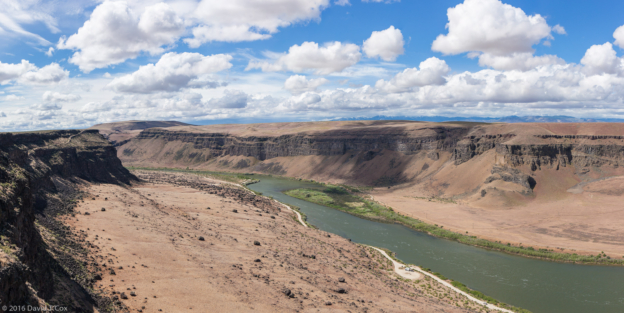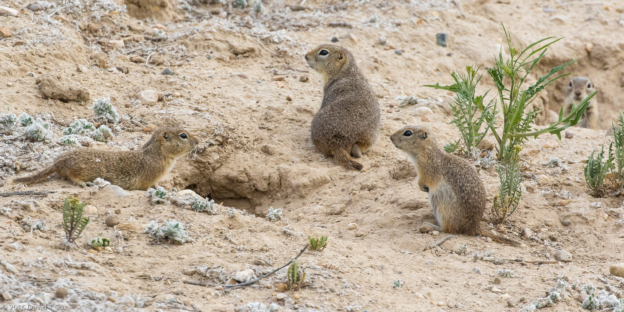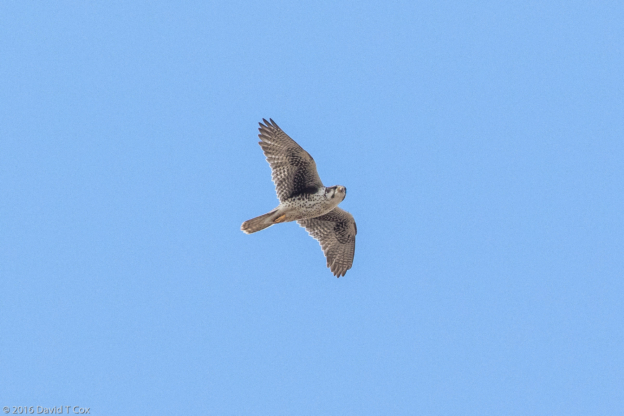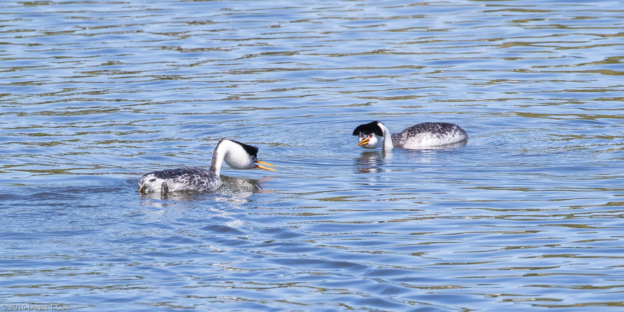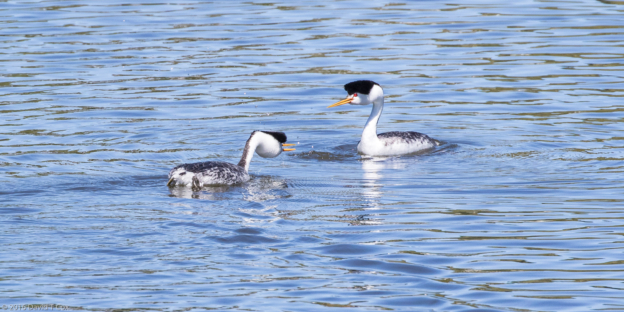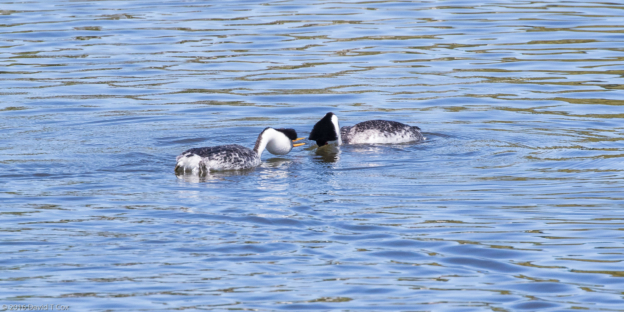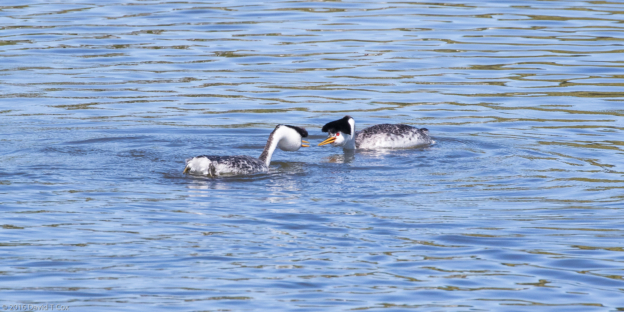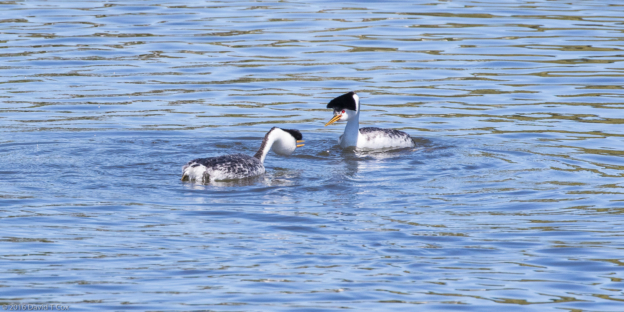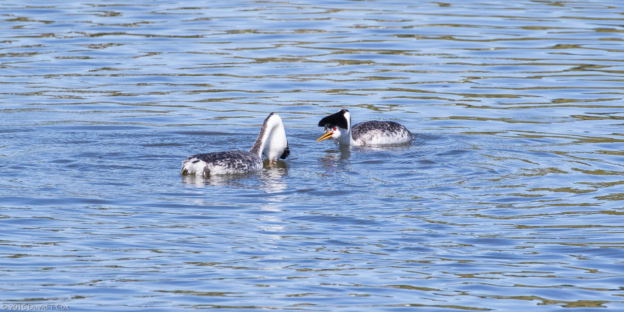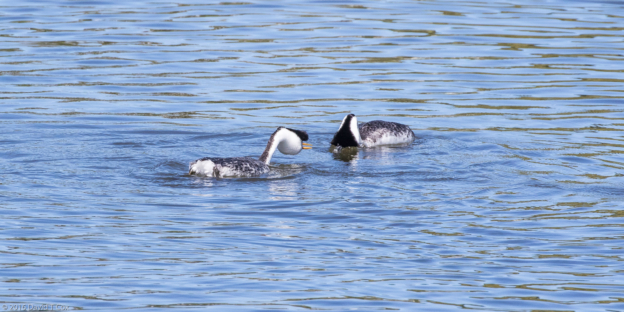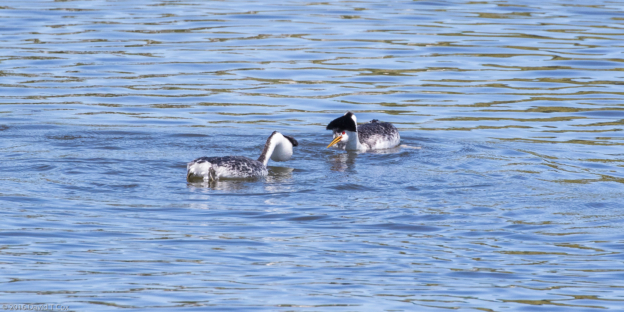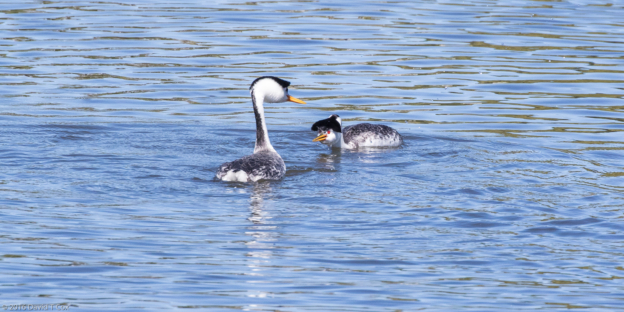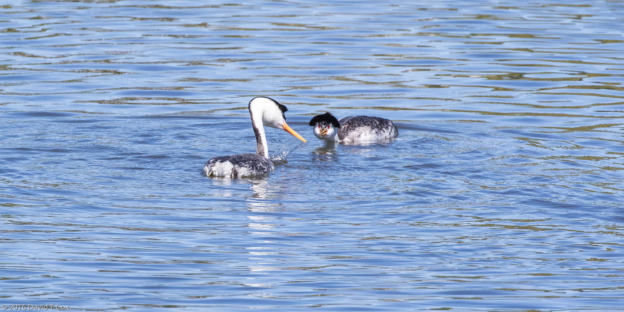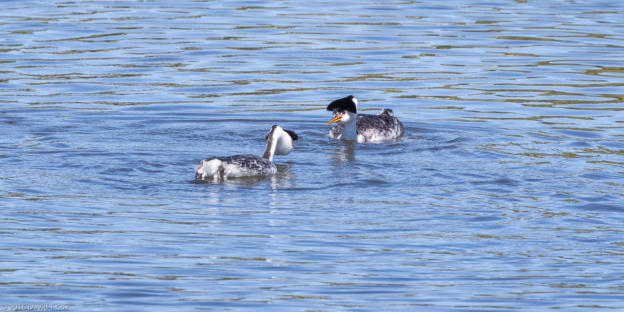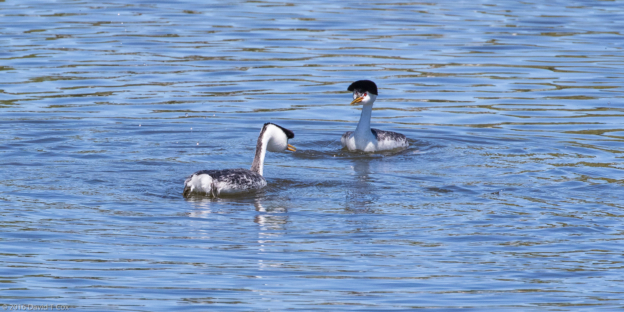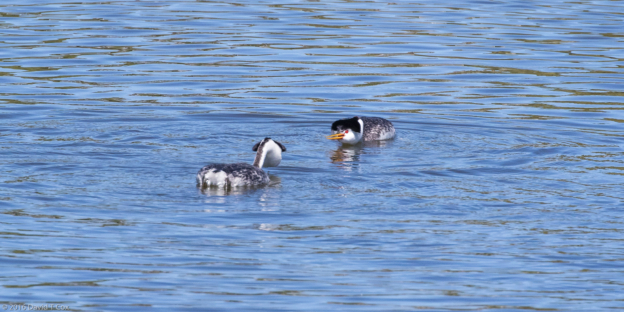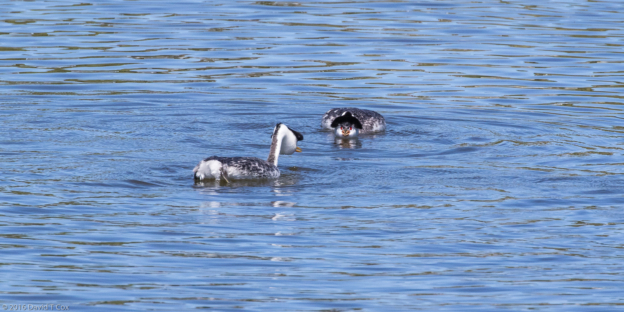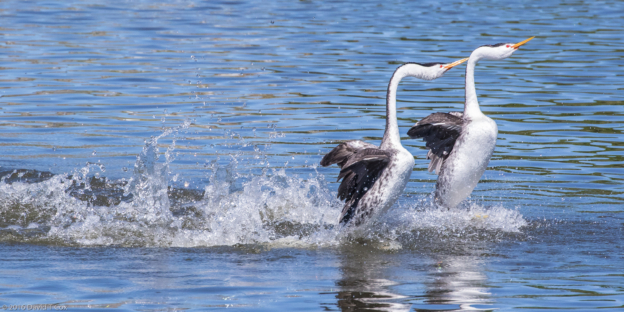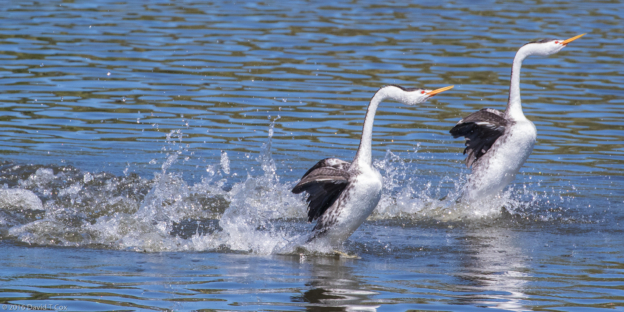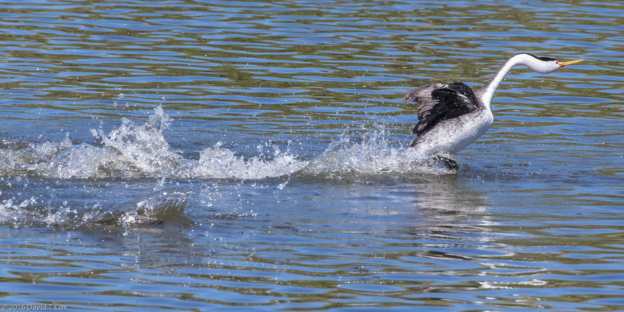All Photos Are Below the Travelogue Text
Click on Any Photo To Open Slide Show
To print the travelogue, right click anywhere on the page. Choose "Print" from your browser dialog box. You can choose Save to PDF in the browser print window.
Share your thoughts.
Email Dave - coxdavid55@hotmail.com
Hello everyone. I last wrote just after arriving in Klamath Falls, OR, and was then starting my birding around the lake. I remained for 6 days, and spent each morning visiting Putnam Point, at the south end of Klamath Lake where it flows into the Klamath River. This probably is the best spot in the world to view both Clark’s and Western Grebes during breeding season. The two species are very similar, distinguishable only by the placement of the black cap above the eye, and the subtle beak color. Both species re-establish mating pairs in April and early May, and engage in spectacular courtship rituals. Patience and time spent observing them paid off with some action photos, including the most spectacular ritual, the courtship dance.
The “Dance” normally starts with what I call the “Challenge” – a pair, either of Clark’s or Western Grebes, face off on the water, with necks extended forward and low over the water, the jet black hood feathers raised to produce a half moon over the face. The two face each other from about 1 foot. Five different ritualistic head movements were displayed during the Challenge phase, which itself lasts from a few to 20 seconds. The pair in the face-off alternate the very distinct head and neck positions, which include: head low and fully forward on the long neck, “glaring” at the other; head dunking forward and under water; head and neck raising up high above the level of the other; flipping water to one side with the beak; and turning the lowered head 45 degrees to one side. After the challenge, with no warning the eye can discern, the birds take off “running” on their legs at right angles to their Challenge faceoff position. Within a second or so they lift their bodies fully up and out of the water, literally running on top of the water, side by side, continuing for up to 60 feet while leaving a trail behind of boiling water. They run with wings pinned open and back, necks arching upward and curving forward, with the head and beak tilted back up. This running on water is called “Rushing”. At the end of the Rush, both birds dive under water. The Challenge and Rush are considered one of the most remarkable animal courtships of any animal species on earth. National Geographic reported on a study done last year researching how this bird can literally run on water; it is the largest vertebrate in the world that can do so. High speed cameras show the grebes taking around 20 steps per second (the world’s Olympic sprinters are just approaching 5 strides per second), with the webbed feet angling out sideways for each return stroke. I have included a separate photo gallery with a number of photos taken in rapid series which, if you click through them using the slide show, will give a visualization of this spectacular courtship – this gallery starts with the 24th photo below. The slide show is started by simply right-clicking on any photo in the gallery. (I obtained some video, but the still photos are much higher resolution quality).
Link to Clark’s Grebes Courtship Gallery
Other Grebe rituals include engagement in what I call the “Necking” ritual, often after chasing off an intruder who came too close to the pair’s space. The pair will raise their heads straight up on the very long necks, then, alternately, or simultaneously, coil their neck down pulling their head onto their back where they will grab at a feather with the beak. This ritual can continue for 10 to 20 seconds. The birds have in addition a “Weed” ceremony that occurs at the site of nesting, but this I did not observe. I did, however, observe what I call failed Challenge and Rush ceremonies. Twice I observed a pair of Western Grebes start the Challenge faceoff phase, which continued normally for a number of seconds, followed by just one of the grebes taking off for the Rush; the other just sat and watched the lonely Rush of the other. Indeed, the second time I photographed this, I was astonished that, as soon as the poor lone grebe took off on the Rush, the remaining one almost immediately stopped watching, turned and dove under water for fishing. Brutal. I automatically assumed in both cases it was the female who presented the false Challenge, because it so reminded me of Lucy eternally promising Charlie Brown that this time she would not pull away the football. (I expect some guff for admitting my assumption, as the sex of the grebes is indistinguishable). Finally, over several days I watched the same complaining juvenile grebe follow an adult, making begging noises insistently for food; the adult completely ignored the youngster, even after catching and bringing a fish to the surface (the fish usually are consumed underwater).
I visited Lower Klamath Nat. Wildlife Refuge twice more, and continued to see a very large variety of birdlife. A Golden Eagle in first year plumage grabbed a partially grown Canada Goose gosling. Although I only got a quick photo of the eagle air-born after dropping the gosling, I did photograph the parent geese trying to shelter the remaining goslings from further predation. Later, in the same area I observed a coyote hunting the banks. All the predators knew it was easy feasting this time of year.
From Klamath Falls I drove the short distance to Bend, OR, where I stayed just a day, and then drove on to the small town of Homedale, Idaho to stay at the green Snake River RV Park right on the river. My target was the very long-named “Morley Nelson Snake River Birds of Prey Conservation Area,” encompassing the Snake River Canyon; it provides the densest raptor nesting area in the US and probably the world. Eighteen different species of raptors congregate here, most using the area for nesting along the basalt cliffs over the Snake River. The plateaus above the cliffs are covered with grasslands bored full of the holes of countless Piute Ground Squirrels, which, together with Black-tailed Jackrabbits, provide the main nourishment for the nesting raptors. The area particularly is famous for the nesting Prairie and Peregrine Falcons, together with Golden Eagles and three different species of Buteo Hawks. Unfortunately, both days I had scheduled for driving the cliff ledges were rainy and extremely windy – poor weather for the nesting raptors to be hunting, though I got a few decent photos.
On Tuesday I drove to the tiny town of Arco, Idaho, close to the Craters of the Moon National Monument which covers one of the major volcanic hotspots of the last several thousand years. I spent one afternoon visiting, but had, unfortunately, again bad weather. The tiny town of Arco, population about 900, sits below a cliff face (really a hundred faces) with almost every face of the cliff marked in white paint by each high school class year, starting from about 1920.
Wednesday I drove north through the beautiful Salmon and Bitterroot Valleys, from Idaho into Montana, to visit Loey, a high school friend from my time in boarding school in India. We drank wine out on her magnificent yard and reminisced about long-ago times and school mates who still seem as family. Loey is planning our 50th class reunion to be held next summer at her location in Montana. From Stevensville I drove to Bozeman for a last few days before my planned 10 day stay inside Yellowstone Nat. Park, where I will have no Wi-Fi or cell phone access for the duration. Later. Dave
PS. Below are two separate photo galleries available for slide show. Click any picture of the top 23 photos for a set of pictures covering the travelogue. Below those start a second gallery, starting after the Swainson’s Hawk in flight; this gallery shows a complete series of Grebe’s Challenge and Rush ritual, which can be viewed, rapidly advancing through the pictures, to get a sense of the actual ceremony – this set of photos starts with the 24th photo below and is labeled at that point.
Link to Clark’s Grebes Courtship Gallery
- Putnam Point, Klamath Falls, OR
- Clark’s Grebe Challenge and Dance Series 5, Putnam Point, Klamath Falls, OR
- Clark’s Grebe Dance Series 3, Putnam Point, Klamath Falls, OR
- Clark’s Grebe Challenge and Dance Series 5, Putnam Point, Klamath Falls, OR
- Clark’s Grebe Challenge and Dance Series 4, Putnam Point, Klamath Falls, OR
- Clark’s Grebe Challenge and Dance Series 4, Putnam Point, Klamath Falls, OR
- Clark’s Grebe with fish, young begging, Series 12, Putnam Point, Klamath Falls, OR
- Mule Deer on the bridge, Putnam Point, Klamath Falls, OR
- Great Horned Owl, Moore Park, Klamath Falls, OR
- Great Horned Owl, Moore Park, Klamath Falls, OR
- Cinnamon Teal, Lower Klamath National Wildlife Refuge, CA
- Golden Eagle with Canada Goose gossling, Lower Klamath National Wildlife Refuge, CA
- Canada Goose parents defending gosslings from Golden Eagle, Lower Klamath National Wildlife Refuge, CA
- Guffey Railroad Bridge, Celebration Park, Snake River Nat Wildlife Conservation Area, ID
- California Quail, Snake River Nat Wildlife Conservation Area, ID
- Horned Lark, along Snake River Birds of Prey NCA, ID
- Common Goldeneye, Swan Falls Dam, Snake River Birds of Prey Nat. Cons. Area, ID
- Snake River Birds of Prey Nat Conservation Area panorama, ID
- Rock Wren with grasshopper, Destination Point, Snake River Birds of Prey Nat. Cons. Area, ID
- Piute Ground Squirrel, Snake River Nat Wildlife Conservation Area, ID
- Northern Harrier, along Snake River near ferry crossing, ID
- Prairie Falcon, Destination Point, Snake River Birds of Prey Nat. Cons. Area, ID
- Swainson’s Hawk protecting fledgeling in nest, along Snake River near ferry crossing, ID
–
Full Series of Clark’s Grebes Challenge and Rush Courtship Ritual Below.
- Clark’s Grebe Long Challenge and Dance Series 6, Putnam Point, Klamath Falls, OR
- Clark’s Grebe Long Challenge and Dance Series 6, Putnam Point, Klamath Falls, OR
- Clark’s Grebe Long Challenge and Dance Series 6, Putnam Point, Klamath Falls, OR
- Clark’s Grebe Long Challenge and Dance Series 6, Putnam Point, Klamath Falls, OR
- Clark’s Grebe Long Challenge and Dance Series 6, Putnam Point, Klamath Falls, OR
- Clark’s Grebe Long Challenge and Dance Series 6, Putnam Point, Klamath Falls, OR
- Clark’s Grebe Long Challenge and Dance Series 6, Putnam Point, Klamath Falls, OR
- Clark’s Grebe Long Challenge and Dance Series 6, Putnam Point, Klamath Falls, OR
- Clark’s Grebe Long Challenge and Dance Series 6, Putnam Point, Klamath Falls, OR
- Clark’s Grebe Long Challenge and Dance Series 6, Putnam Point, Klamath Falls, OR
- Clark’s Grebe Long Challenge and Dance Series 6, Putnam Point, Klamath Falls, OR
- Clark’s Grebe Long Challenge and Dance Series 6, Putnam Point, Klamath Falls, OR
- Clark’s Grebe Long Challenge and Dance Series 6, Putnam Point, Klamath Falls, OR
- Clark’s Grebe Long Challenge and Dance Series 6, Putnam Point, Klamath Falls, OR
- Clark’s Grebe Long Challenge and Dance Series 6, Putnam Point, Klamath Falls, OR
- Clark’s Grebe Long Challenge and Dance Series 6, Putnam Point, Klamath Falls, OR
- Clark’s Grebe Long Challenge and Dance Series 6, Putnam Point, Klamath Falls, OR
- Clark’s Grebe Long Challenge and Dance Series 6, Putnam Point, Klamath Falls, OR
- Clark’s Grebe Long Challenge and Dance Series 6, Putnam Point, Klamath Falls, OR
- Clark’s Grebe Long Challenge and Dance Series 6, Putnam Point, Klamath Falls, OR
To print the travelogue, right click anywhere on the page. Choose "Print" from your browser dialog box. You can choose Save to PDF in the browser print window.
Share your thoughts.
Email Dave - coxdavid55@hotmail.com
